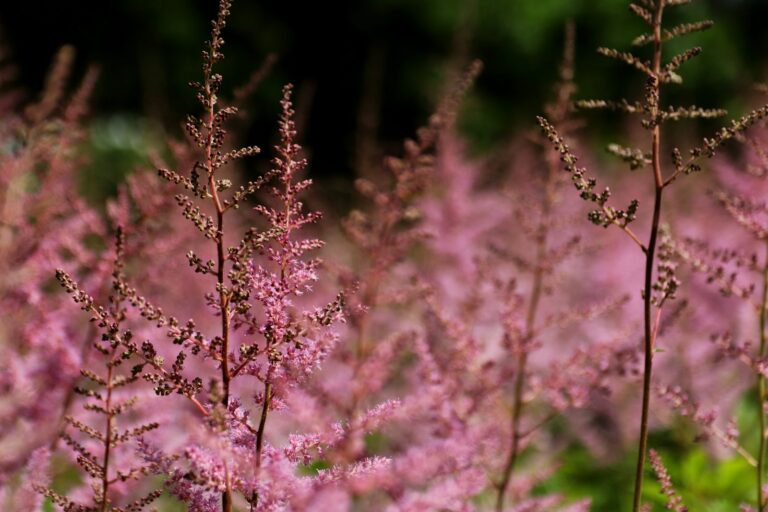Fall Astilbe Care: Autumn Preparation & Maintenance
Astilbe plants maintain consistent moisture levels until the ground freezes while thriving astilbe receives proper autumn care through the dormant period. The difference stems from fall watering schedules paired with two-inch mulch applications after frost[1][2]. Here is how to strengthen your astilbe for winter survival.
Understanding Fall Astilbe Care Essentials
You’ll need to care for your astilbe plants through autumn even when they are no longer blooming. These shade-loving perennials prime themselves for dormancy in fall months, and the maintenance you offer now defines spring strength. Activities to perform in the autumn are all four necessary acts in order to preserve roots and to encourage healthy return growth.
When maintained properly, astilbe tolerates temperatures, such as those in zones 3 through 9 during winter, without special protection from temperature reductions or frost extremes. The result of the best preparation is that in the north, plants can tolerate temperatures as low as minus thirty degrees with sufficient provisions. The secret is to perform exact duties during autumn months before the first big winter cold begins.
Dividing Astilbe in Fall
Fall is an excellent time of year for dividing old clumps that have been growing three to four years. Thick rhizomes of matured astilbe, for example, will develop and they benefit from breaking apart at times of this season. The soil is warm enough for new roots to have grown in the time before winter dormancy starts[2][5].
Division Timing and Technique
Astilbe is divided depending on the spring or fall when it is applied. The best split on the plant is usually best done in fall division between four and six weeks prior to the average first frost date. This interval gives roots time before dormancy a good opportunity to settle roots through, so that there is enough time to establish prior to dormancy and create roots at this new home to develop enough time to come into place.
Avoid damaging rhizomes by digging approximately six inches off the ground, at least six inches around the plant about root roots. Leverage a long, lever-based shovel to extend ten to twelve inches deep and move the root mass up to it.
Replanting Divided Sections
Divide the clump into fragments by gently picking off roots with your fingers. Every division requires attached foliage and healthy roots. At this level of spacing, replant divisions one to three feet apart from the original, depending on the size of your variety. You should water deeply and evenly on planting and maintain steady moisture throughout the fall.
The key to successful division is proper timing and moisture management throughout the establishment period.
Cutting Back Astilbe: Fall vs. Spring
Reducing foliage creates debate among gardeners with differing seasonal schemes. Some like fall cleanup, and others don’t start till spring. It depends on your garden style and whether plants exhibit signs of disease. Spent flower stalks hold interest in winter when used, but eliminating infected foliage prevents issues with overwintering.
Marking Plant Locations
The plant’s locations should be marked immediately prior to foliage being trimmed, which is important to prevent it from accidentally damaging the plant in the next spring. Make your popsicle sticks durable and plastic labels waterproof markers. Gardeners often forget where dormant perennials are and trip over them during spring cleanup or planting.
Pruning Methods
Use clean, sharp pruners to prune stems to three inches above ground level. Instead of leaving all the cut material in the garden, remove the cut materials from the garden. Decaying plant debris attracts diseases and rodents that damage roots. Dried flower stalks work well in indoor arrangements if you want to preserve them[1].
Leaving Stalks for Winter Interest
It may be easy and natural, but some gardeners seem to prefer for flower stalks to remain standing all through winter for beauty and wildlife value. Dried seed heads are food for birds in the winter. The skeletal shapes give texture to winter gardens when everything else is gone. This is the option of choice if plants do not appear diseased.
Fall Watering Requirements
Keep watering astilbe until the ground freezes, until the winter. These plants are moisture-loving, where they need consistent hydration when they’re not actively growing. Soil that is wet carries more heat compared to dry soil, and can prevent the roots from harm during cold snaps[2][3]. Water deeply with water at least once a week if the sun is not shining.
In the dry low weather of fall, keep an eye on moisture level, even when temperatures are cool. Early types of astilbe need constant water to develop strong roots before dormancy. Water-containing plant tissue is less susceptible to frost than dehydrated tissue[2].
Fertilizing Astilbe Before Winter
Use a slow-release fertilizer with a middle number at least as high as the other two numbers such as 5-10-5 or 10-10-10. Fertilize in late fall while the ground remains soft but cool enough to prevent new growth. Well developed plants fare better enough to tolerate winter stress than poorly feeding specimens[2][7].
Application Timing
Apply fall fertilizer when growth slows, but before the earth freezes. When leaves get dry, push aside mulch and rake granules into the soil to prevent chemical burns. Consequently, early-blooming astilbe varieties produce buds in autumn to produce the flowers of the next season, which therefore makes the fall fertilization of astilbe a key event[7].
Key fertilizing tips:
- Choose balanced or phosphorus-rich formulas
- Apply when soil is moist but foliage is dry
- Push aside mulch before application
- Water in fertilizer after applying
- Avoid late applications that stimulate new growth
Mulching for Winter Protection
Place a two-inch thick layer of organic mulch over plants on the ground after the ground freezes. This timing keeps from rodent damage and getting damp from mulch early. Compost as a buffer soil-based or mulched manure which also adds additional insulation to the soil and slowly affects the soil quality is recommended[1][2][3].
Mulch Material Selection
Select materials for mulching, such as:
- Compost – Adds nutrients while insulating
- Leaf mold – Breaks down gradually through winter
- Shredded bark – Provides long-lasting protection
All these options break down gradually through winter, dissolving nutrients but providing insulation. The introduction of newly-mixed mulch prior to freezing promotes rodent nesting, so timing is as important as depth of mound[1].
Proper Mulch Application
Mulch is also the insulation for the ground which retains moisture and reduces the temperature after it freezes. Apply your two-inch stratum once your soil temperature is continuously under freezing. The organic material protects the crown where foliage meets roots. Place a two-inch gap for moisture to trap the rot on the crown[3].
Spring Mulch Removal
Get rid of the old mulch before spring until new shoots appear. Pour in some fresh organic material at that point to keep moisture and weed at bay all through the growing season. Old mulch can be left to rot and decay on the compost pile.
Creating Your Fall Care Schedule
Astilbe fall care takes less time than spring vigor. Success lies in knowing what you will need in terms of dormancy preparation:
Essential fall tasks include:
- Regular watering until ground freezes
- Appropriate mulch position and depth
- Optional cutting back due to conditions inside the garden
- Fertilizer application to shore up roots
Leaves in full autumn care grow stronger and flower more efficiently. Do the work of watering it and fertilizing and mulching it before winter starts.
Key Sources:
[1] Winterizing Astilbe Plants | Gardening Know How
[2] How to Prepare Astilbe Plants for Winter | Gardener’s Path
[3] How to care for astilbe in the fall | Homes & Gardens
[5] Growing Astilbe | Garden Design
[7] When and How to Fertilize Astilbe | Gardener’s Path
Lily Morgan is a home gardener. She grows houseplants and designs small-space gardens. She shares what she learns from experience. Lily offers simple, practical tips for plant lovers. Her goal is to help others garden with confidence. She wants to help them grow, one leaf at a time.


